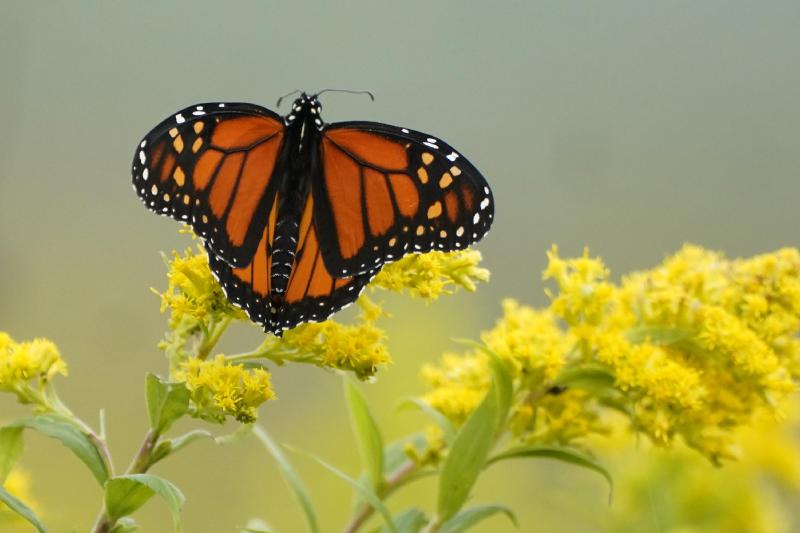Monarch butterflies are in trouble; Here's how you can help | AP News



Close your eyes for a moment and imagine a butterfly. My money says the fluttering insect you're envisioning has black-veined, reddish-orange wings outlined with white specks — the iconic attributes of our beloved American monarch butterfly.
Unfortunately, the species, which populates many childhood memories, is in trouble.
The migrating monarch butterfly was added last week to the "red list" of threatened species and categorized as "endangered" for the first time by the International Union for the Conservation of Nature. That's two steps from extinct in the wild.
Scientists blamed the monarchs' plummeting numbers on habitat loss, climate change, and pesticide and herbicide use.
What can home gardeners do to support the monarch?
If everyone reading this planted one milkweed plant, the benefit would be palpable. Milkweed (Asclepias spp.) is the only plant monarch caterpillars eat, and it's where the adult butterflies lay their eggs. Without it, the species simply could not exist.
"But not all milkweed is the same," says Dawn Rodney, chief innovation and growth officer at the National Wildlife Federation in Reston, Virginia. For instance, "there is an invasive species called tropical milkweed (Asclepias curassavica) that we're seeing more and more, and people are not understanding that it does more harm than good."
The non-native plant is problematic because it blooms for longer and, in temperate regions, does not die back. That can prevent butterflies from recognizing when it's time to migrate, and it can spread deadly parasites to the next year's generation of caterpillars.
To choose the right milkweed, use the National Wildlife Federation's Native Plant Finder ( https://www.nwf.org/nativeplantfinder/ ).
Adult monarchs need other plants too, specifically ones with nectar-bearing flowers. The National Wildlife Federation also has a Monarch Nectar Plant List tool ( https://www.nwf.org/Garden-for-Wildlife/About/Native-Plants/Monarch-Nectar-Guides ), developed with Monarch Joint Venture and Xerces Society, to find plants appropriate for your location.
Choose plants native to your region for the highest-quality food source. Be sure to include late-season bloomers to provide monarchs with fuel for their annual fall migration.
Knowing the source of the plants you buy is important, too.
"There are a lot of growers that use different types of chemicals that are harmful to wildlife," Rodney said, referring to pesticides and herbicides intended to keep plants attractive on retail shelves. When you bring treated plants home, and butterflies lay eggs on them, the caterpillars that follow will die when they munch the leaves.
Neonicotinoid pesticides are especially harmful to the species, Rodney said, as they can kill bees and adult butterflies that ingest the toxic pollen and nectar of treated plants.
Since treated plants aren't labeled as such, Rodney advises asking garden center staff about their pest-management practices. Buying only from trusted, organic sources or growing your own plants from seed are other good options.
This brings me to pesticide use in the home garden. When we use chemicals on our plants, we accept beneficial insects, including monarchs, as collateral damage. We also endanger birds that eat those poisoned insects.
Even natural and organic pesticides can harm butterflies and other pollinators. But if you must use such a product, stick with insecticidal soaps, horticultural oils or Neem oil, and apply them only after dusk, when pollinators aren't active. Unlike many synthetic chemicals, these products lose their effectiveness when dry, so the butterflies will be safer by morning.
Finally, consider going the extra mile by setting up a butterfly puddling station: Create a mud puddle (or add water to sand) in a sunny spot of the yard and set a flat stone within it. Butterflies will sun themselves on the stone to raise their temperatures, and will sip water from the puddle to supplement their nectar diets with the salts, vitamins and minerals they need.
All contents © copyright 2022 The Associated Press. All rights reserved.





Many people in our complex have planted various types of plants (milkweed for one) to help the Monarch. It's not unusual to see Monarchs around us.
Even in the most 'formal' landscapes, I always allow for a 'natural' area where milkweed can be allowed to thrive. A couple of plants can really help. I also gather milkweed seeds and broadcast it out my car window as I drive on my local country roads. I take some pride in seeing my 'patches' the next summer.
Down here on the AZ/Mexico border still plenty of Monarchs to be seen in my neck of the Sonora Desert. My female black lab loves chasing them around the yard.
I don't know when I have (ever) recently seen this (Monarch) butterfly. I will have to keep a keen eye out. Now we have drought conditions in California and so there are not many nearby natural things of beauty being vivid so much. While sitting in the backyard sunning, a (plain) yellow butterfly came by and I observed it rather " intelligently " do a flyover one of my several potted plant with expectation of finding something and with nothing 'flowering' and without breaking its rhythm it fluttered off without investigating anything else in my 'yard.'
Rain/Water shortage is making us all concerned not only about the nature we miss seeing; but that our trees are becoming 'depleted' and weaker little by little each succeedingly dry years.
It is so bad that the other day I saw a dead cricket in my garage and I was startled by it. Not because it was a cricket, not because it was in my garage, but more of a where did it come from kind of thing. After all, we have no rain to drench the creek-bed nearby. And though I have heard that familiar creaking sound several days back. . . it must be the heat that triggered it to come out?
We take our small 'treasures' where we find them out here!
I lived in Monterey CA in the early 80s, next door in Pacific Grove was and is a Monarch butterfly sanctuary. Then there would be several million butterflies waiting for winter to end.
In Dec 19, the count was in the thousands. Some good news, nearly 250,000 butterflies were observed across the West region last winter. It was the highest count since 2016. The region was s the coastal area from from Mendocino to Northern Baja.
I witness the migration in Pacific Grove in the 80's too. It was the most silent, awestruck large group I have ever been a part of. The Monarchs seemed to flap their wings in unison.
Truly awesome. I saw my first lighting bugs this summer recently. It’s terrible what we’ve done to the other life forms that we share this planet with. Payback to us is underway.
I've always liked what George Carlin said about Mother Earth. She will shake humankind off like a case of fleas. I just hope that there's enough left for the rest of the animal kingdom to thrive afterward.
Indeed
Years ago, my hubby saw 100's of thousands crossing the Hudson River across to Manhattan from the Jersey side. He said it was a sight like he has never seen before.
During one of many trips moving one of the kiddos to State College
I hit so many with the van that we had to pull over and wait till they passed.
Pulled into a gas station and they hosed down the van without asking.
There were a couple of monarchs recently at an outdoor event I attended, but they are, sadly, very rare these days.
In the spring of 2019 we did have a painted lady butterfly migration here in Southern California. It lasted for several days and was absolutely amazing. They were everywhere. They came in off the desert. There were a few afternoons during the migration that I sat out in the back yard for a couple of hours at a time watching them come in waves. It was so great. I've never seen anything like it and I really hope it happens again, but it won't happen as long as we're having this terrible drought.
I worked on landscaping job at Indiana Dunes State Park a couple years ago and for the whole week that I was installing plants, Monarchs were migrating along Lake Michigan. At any given time, there were hundreds in the sky. During the heat of the day, they landed on the trees and took a siesta.